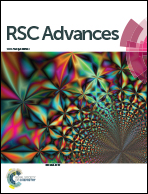Influence of polymer stabilization on the dielectric relaxations of an antiferroelectric liquid crystal
Abstract
Dielectric spectroscopic investigations are reported on an antiferroelectric liquid crystal in its pristine form and when stabilized by a polymer network without and with application of a DC bias field. While the in-phase mode associated with the helix distortion is hardly affected, the high frequency mode connected with the antiphase fluctuations shows a large decrease with increasing concentration of the photoactive monomer used to generate the polymer stabilization. With the help of X-ray data, we rule out any inter-layer nanophase segregation of the polymer strands, and argue that this strong effect is due to the large elastic interaction between the liquid crystal molecules and the polymer strands. Employing expression from a Landau theory we extract several relevant parameters, including the viscosities associated with the different relaxation modes, the elastic constant, and importantly the antiferroelectric interaction, which exhibits a substantial decrease upon polymer stabilization.


 Please wait while we load your content...
Please wait while we load your content...